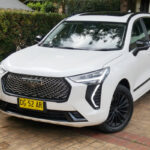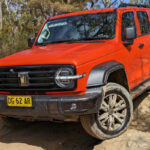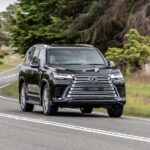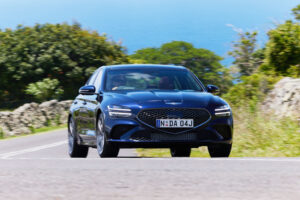
Jolion is the latest offering in an expanding range of SUVs from Chinese manufacturer
Haval GWM. By the way, Jolion means ‘first love’ in Chinese.
You remember them, the guys that got the tradies all hot and bothered back in 2009 with
cheap utes, followed soon after by the X200/X240 SUV based on the same platform.
It was all about the price, but safety soon became an issue and the brand disappeared off
the lots for a while it addressed this problem.
A couple of years ago Great Wall Motors became simply GWM, but it’s still a bit confusing
because Jolion is a Haval and a GWM at the same time — and it carries both badges.
Whatever. The vehicles now come with a full array of safety equipment, with a range that
chops and changes but now includes Jolion, the larger H6 and H6GT (coupe-shaped).
Jolion is the smallest and cheapest of the SUVs.
STYLING
Styling is a bit of a mixed bag. It doesn’t add to the genre, but then it’s in keeping with
most of the offerings in this segment.
Jolion is priced from $28,490 for the Premium grade, $30,990 for the Lux, $33,990 for the
Ultra, and $34,485 for the recently added Vanta with a fashionable black visage. Metallic
paint adds $495. All prices are driveaway.
Standard kit includes two-zone climate air, PM2.5 air filter, faux leather upholstery, real
leather wrapped steering wheel, heated front seats, six-way electrically adjustable driver’s
seat four-way adjustable passenger seat.
Jolion Ultra sits on 18-inch alloys, with a panoramic sunroof, LED headlights, DRLs and
fog lights, auto-dimming rear view mirror, auto lights and wipers, rear parking sensors plus
a 360-degree camera.
It is backed by a 7-year unlimited kilometre warranty, 5 years roadside assist and 5 years
Capped Price Servicing.
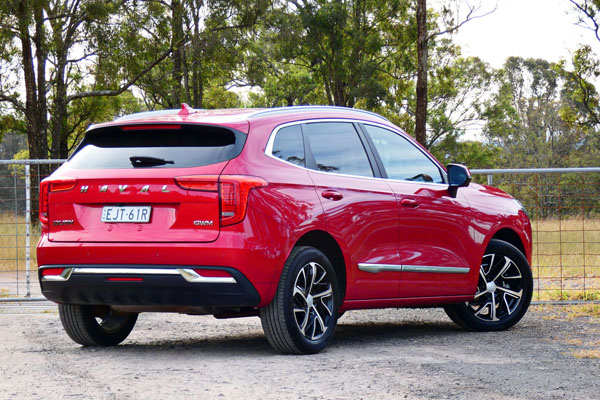
INFOTAINMENT
Infotainment consists of a big, bright 12.3-inch touchscreen, six-speaker audio with DTS
sound processing, Bluetooth, AM/FM radio, Android Auto and Apple Carplay, wireless
phone charging, with a front USB port for data and charging and another one in the back
for charging only — plus a single 12-volt outlet in the front.
Bearing in mind that Ultra was the top-of-the-line model, until Vanta came along, what it
doesn’t get is satellite navigation or DAB+ digital radio — two big ticket items in car
entertainment these days.
Yes, you can hook up your phone through CarPlay or Android Auto, and use it to provide
navigation directions — but try getting it to work when you don’t have access to internet.
ENGINES / TRANSMISSIONS
Power is delivered by a 1.5 litre four-cylinder turbocharged petrol engine with outputs of
110kW from 5600 to 6000 revs and 220Nm of torque from 2000 to 4400 revs. It’s the latter
available across a reasonably wide band that gives the car its get up and go.
The engine is mated to a new generation 7-speed DCT transmission (twin clutch auto),
with power pushed to the front wheels.
SAFETY
Jolion is yet to be tested by the ANCAP organisation, but offers a comprehensive range of
safety support systems, including seven airbags, a rear-view camera with guidelines and
Autonomous Emergency Braking with pedestrian and bicycle detection.
There’s also Heads Up Display, Lane Departure Warning (LDW), Lane Keep Assist (LKA),
Adaptive Cruise Control (ACC), Traffic Sign Recognition (TSR), Lane Change Assist with
Blind Spot Monitoring (BSM) and Rear Cross Traffic Alert (RCTA).
Of note is the driver fatigue camera that protrudes like an accusing finger from the front,
driver-side pillar is quick to tell you when you’re doing the wrong thing.
In fact, you’re likely to get sick of it and go looking for a switch to turn it off. We thought
about it.
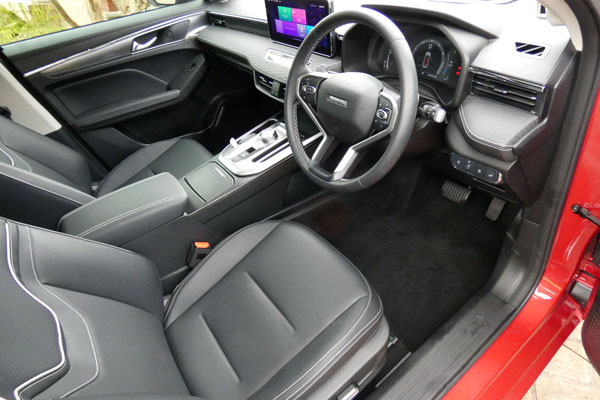
DRIVING
Jolion is quite large and comfortable for the price, with heated power-adjust front seats, air
for back seat passengers and a handy-sized boot, with a space saver spare under the
floor.
But BLEEP, the steering wheel does not have reach adjustment.
There are four driving modes, Normal, Eco, Sport and Snow, with fuel consumption a
claimed 8.1L/100km on the combined cycle from a 60-litre tank.
Built on the company’s new LEMON global lightweight modular platform, Jolion replaces
the previous, smaller H2.
It’s 4472mm long, 1841mm wide, and 1619mm high, with a 2700mm wheelbase, with a
kerb weight of 1345 to 1370kg, giving it the edge over many competitors.
The ride feels reasonably comfortable on well-formed surfaces, but can be harsh at other
times.
Swap to a Japanese SUV for comparison purposes and you might change your mind,
however. Mitsubishi’s Eclipse Cross is a good example, because it has a far more refined
ride.
The 1.5-litre turbocharged engine offers a good compromise between performance and
fuel economy.
But again, there is an issue with refinement, because throttle response is jerky and
sporadic, and can be an issue in low-speed parking manoeuvres.
Like a lot of twin clutch transmissions, it can be slow to hook up.
Changing between forward and reverse with the round gear selector can also be tricky
when you’re in a hurry, say if you overshoot a driveway and have to do a short, quick
backup.
To switch between drive modes, you need to access the infotainment system.
We tried Sport mode which became intolerable after a while, but it is one of the few cars
that we have driven that will stay in the selected mode between starts.
The head-up display is a bonus. So is speed sign recognition.
But the adaptive cruise control system could also do with some refinement, especially
when it brakes for no apparent reason, with constant tugging on the wheel even when the
indicator has been activated (which should indicate to the system you are changing lanes
on purpose).
Then there’s the repeated warnings that you’re too close to the vehicle in front. Drop back
and someone is sure to cut in.
And what about the “smart dodge function” which steers the car to the right if you’re
passing a truck or bus.
WTF?
Accessing the trip computer can be a challenge. The trick is to hold down the OK button
on the right side of the steering wheel and wait for the display to change, which can take
several seconds.
After that, you can cycle through the different screens, but it quickly reverts to the standard
screen once you’re moving.
The audio is okay, but not quite on par with competitors, even with DTS processing.
We were getting 7.8L/100km after 537km, with another couple of hundred kilometres to
go, and it takes standard 91 RON unleaded.
Boot space is a generous 430 litres with the rear seats in place, or 1133L with them folded
and the wagon has a 1500kg braked tow capacity.
SUMMING UP
You’ve probably heard it before, but the Jolion is surprisingly good, offering plenty of car
for a bargain price.
A friend recently bought one of these cars. When I told him I didn’t have him pegged as a
Haval buyer, he shrugged and said: “I needed a car now. I wasn’t prepared to wait 12
months.”
So, everyone else’s loss could be Great Wall’s gain in this crazy, topsy-turvy world in
which we now live.
RATINGS:
Looks: 7/10
Performance: 7/10
Safety: 8/10
Thirst: 7.5/10
Practicality: 8/10
Comfort: 7.5/10
Tech: 7.5/10
Value: 8/10
Overall: 7.6/10
AT A GLANCE
MODEL RANGE
Jolion 1.5 Premium, $27,490
Jolion 1.5 Lux, $29,990
Jolion 1.5 Ultra, $32,990
Jolion 1.5 Vanta, $34,485
Note: These are driveaway prices.
SPECIFICATIONS (Haval Jolion Ultra 1.5-litre turbo-petrol five-door wagon)
ENGINE:
Capacity: 1.5 litres
Configuration: Four cylinders in line, turbocharged
Maximum Power: 110 kW @ 5600 rpm
Maximum Torque: 220 Nm @ 2000 rpm
Fuel Type: Standard unleaded petrol
Combined Fuel Cycle (ADR 81/02): 8.1 L/100km
CO2 Emissions: 186 g/km
DRIVELINE:
Seven-speed dual clutch automatic, front-wheel drive
DIMENSIONS, WEIGHT AND CAPACITIES:
Length: 4472 mm
Wheelbase: 2700 mm
Width: 1841 mm
Height: 1574 mm
Turning Circle: N/A
Kerb Mass: 1400 kg
Fuel Tank Capacity: 60 litres
BRAKES:
Front: Ventilated disc
Rear: Solid disc
STANDARD WARRANTY:
Seven years / unlimited kilometres




